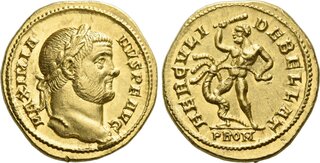| Numismatica Ars Classica > Auction 146 | Auction date: 8 May 2024 |
| Lot number: 2389 Price realized: This lot is for sale in an upcoming auction - Bid on this lot  | Show similar lots on CoinArchives Find similar lots in upcoming auctions on |
| Lot description: Maximianus Herculius, 286 – 310. Aureus 294, AV 18 mm, 5.99 g. MAXIMIA – NVS P F AVG Laureate head r. Rev. HERCVL – I DEBELLAT Hercules standing l., fighting Hydra with club in r. hand; in exergue, PROM. C 255. RIC –. Depeyrot 9/5. Calicó 4660 (this coin illustrated). Very rare and in exceptional condition for this interesting and fascinating issue. Virtually as struck and almost Fdc Ex Triton II, 1998, 1040; Triton V, 2002, 2149 and Gemini XIII, 2017, 224 sales. From the Jürgen K. Schmidt collection. This coin illustrated in The Roman Aurei by X. E. Calicó. Around the time the Tetrarchy was formed in 293, minting in the empire began to increase, partly because the size of the imperial bureaucracy had perhaps doubled, and the needs of the army were not lessened. Furthermore, there were donatives for Diocletian's decennalia and the courts and bodyguards of the new Caesars Constantius I and Galerius had to be established. All of these expenses carried into 294, when this aureus was struck at the Rome mint, about the time Diocletian implemented his monetary reform. In the West the increase in expenses was piqued in 293 with the mounting of a fresh offensive against Carausius, the naval commander-turned-rebel who since 286 (or possibly early 287) had ruled Britain and controlled much of the north-western coast of Gaul. All this meant that the mint at Trier resumed production (in 293/4) after a 20-year hiatus, and that in 293 a temporary mint was established at Iantinum (Meaux). If recent events were any guide, the success of this new venture was far from guaranteed. Maximian already had failed twice to defeat Carausius: in the spring of 289 he suffered a great naval disaster when moving against the rebel, and two years later a second attempt seems to have been thwarted, though no details of it survive. This was a source of great embarrassment to Maximian, who ultimately had to answer to Diocletian, the senior emperor in the East. It also took a great toll on the resources of the Western provinces, and threatened to inspire other would-be rebels. Thus, when the new campaign was mounted in 293, success was essential. Maximian was relying on Constantius, his former praetorian prefect and new Caesar, who had proven his skills as a commander in the previous years. He had registered impressive (if somewhat brutal) victories against Carausius' Frankish allies in the estuaries of the Rhine, trekking as far as the shores of the North Sea. Now, without the luxury of a fleet, he had to focus on defeating the rebel's allies in Gaul. The campaign was fraught with hardship and uncertainty, but Constantius emerged victorious after he forced the surrender of Bononia (Bologne), Carausius' major stronghold in Gaul. Constantius blocked the entrance to this port-city by a feat of engineering that seems to have given way to the rising tide only hours after the city had capitulated. It is not known if Carausius was in the city and escaped, or if he had been in Britain throughout the siege, but the loss of Bologne and the consequent surrender of the rest of the Continental allies caused his murder, seemingly by his successor Allectus. Several coin types refer to this campaign, including the reverse of this aureus, which is dedicated "to Hercules the vanquisher" who is shown in the midst of his second labour, the defeat of the Lernaean Hydra. The message is clear, for Hercules was the patron deity of the ruling house of Maximian and Constantius, and the allusion of this coin type to this fresh and inspiring victory cannot be missed. Estimate: 25000 CHF |  |



